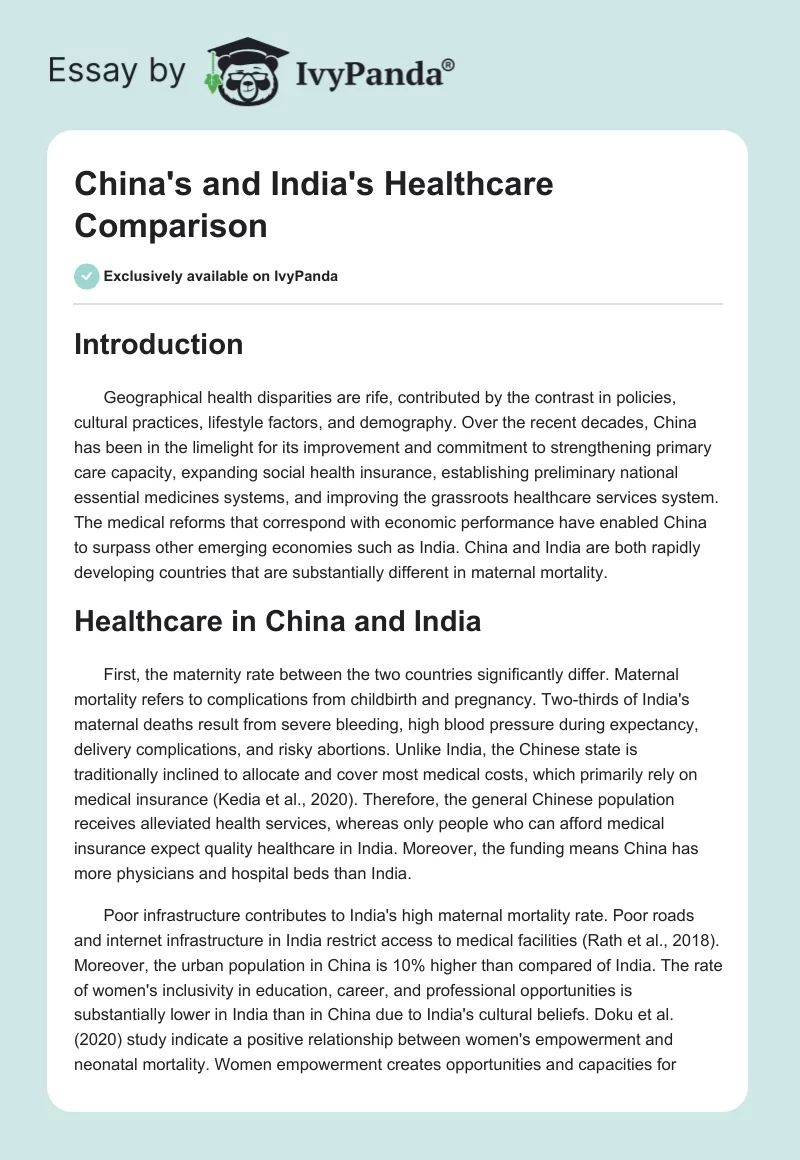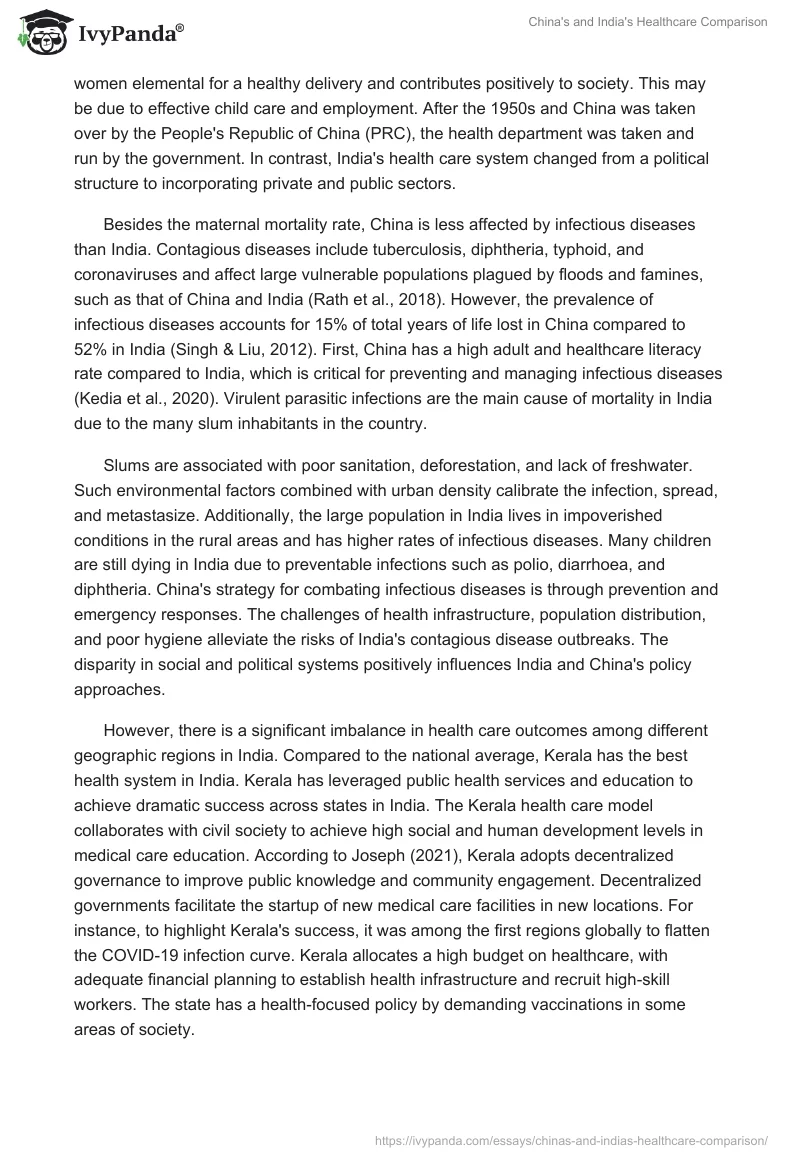Introduction
Geographical health disparities are rife, contributed by the contrast in policies, cultural practices, lifestyle factors, and demography. Over the recent decades, China has been in the limelight for its improvement and commitment to strengthening primary care capacity, expanding social health insurance, establishing preliminary national essential medicines systems, and improving the grassroots healthcare services system. The medical reforms that correspond with economic performance have enabled China to surpass other emerging economies such as India. China and India are both rapidly developing countries that are substantially different in maternal mortality.
Healthcare in China and India
First, the maternity rate between the two countries significantly differ. Maternal mortality refers to complications from childbirth and pregnancy. Two-thirds of India’s maternal deaths result from severe bleeding, high blood pressure during expectancy, delivery complications, and risky abortions. Unlike India, the Chinese state is traditionally inclined to allocate and cover most medical costs, which primarily rely on medical insurance (Kedia et al., 2020). Therefore, the general Chinese population receives alleviated health services, whereas only people who can afford medical insurance expect quality healthcare in India. Moreover, the funding means China has more physicians and hospital beds than India.
Poor infrastructure contributes to India’s high maternal mortality rate. Poor roads and internet infrastructure in India restrict access to medical facilities (Rath et al., 2018). Moreover, the urban population in China is 10% higher than compared of India. The rate of women’s inclusivity in education, career, and professional opportunities is substantially lower in India than in China due to India’s cultural beliefs. Doku et al. (2020) study indicate a positive relationship between women’s empowerment and neonatal mortality. Women empowerment creates opportunities and capacities for women elemental for a healthy delivery and contributes positively to society. This may be due to effective child care and employment. After the 1950s and China was taken over by the People’s Republic of China (PRC), the health department was taken and run by the government. In contrast, India’s health care system changed from a political structure to incorporating private and public sectors.
Besides the maternal mortality rate, China is less affected by infectious diseases than India. Contagious diseases include tuberculosis, diphtheria, typhoid, and coronaviruses and affect large vulnerable populations plagued by floods and famines, such as that of China and India (Rath et al., 2018). However, the prevalence of infectious diseases accounts for 15% of total years of life lost in China compared to 52% in India (Singh & Liu, 2012). First, China has a high adult and healthcare literacy rate compared to India, which is critical for preventing and managing infectious diseases (Kedia et al., 2020). Virulent parasitic infections are the main cause of mortality in India due to the many slum inhabitants in the country.
Slums are associated with poor sanitation, deforestation, and lack of freshwater. Such environmental factors combined with urban density calibrate the infection, spread, and metastasize. Additionally, the large population in India lives in impoverished conditions in the rural areas and has higher rates of infectious diseases. Many children are still dying in India due to preventable infections such as polio, diarrhoea, and diphtheria. China’s strategy for combating infectious diseases is through prevention and emergency responses. The challenges of health infrastructure, population distribution, and poor hygiene alleviate the risks of India’s contagious disease outbreaks. The disparity in social and political systems positively influences India and China’s policy approaches.
However, there is a significant imbalance in health care outcomes among different geographic regions in India. Compared to the national average, Kerala has the best health system in India. Kerala has leveraged public health services and education to achieve dramatic success across states in India. The Kerala health care model collaborates with civil society to achieve high social and human development levels in medical care education. According to Joseph (2021), Kerala adopts decentralized governance to improve public knowledge and community engagement. Decentralized governments facilitate the startup of new medical care facilities in new locations. For instance, to highlight Kerala’s success, it was among the first regions globally to flatten the COVID-19 infection curve. Kerala allocates a high budget on healthcare, with adequate financial planning to establish health infrastructure and recruit high-skill workers. The state has a health-focused policy by demanding vaccinations in some areas of society.
Conclusion
In conclusion, China and India have experienced dramatic economic, demographic, and societal transformations since the 20th century. Arguably, China has had more success in recording better health outcomes than India over the last five decades. However, the health status in India still lags behind relative to maternal mortality and the rate of infectious diseases. The maternity mortality rate is highly prevalent in India compared to China due to better allocations, services, and women’s inclusivity. The geographic disparity in healthcare quality is evident in internal subpopulations. The lack of epidemiological transition in India, characterized by dense urban slums, cause higher rates of infectious diseases than in China. Contrary to the national average and other Indian states, Kerala has achieved superior health outcomes by leveraging public knowledge, quality of services and health infrastructure. Due to its ability to effectively manage healthcare and resources, Kerala can work with catastrophes like the COVID-19 pandemic.
References
Doku, D. T., Bhutta, Z. A., & Neupane, S. (2020). Associations of women’s empowerment with neonatal, infant and under-5 mortality in low-and/middle-income countries: a meta-analysis of individual participant data from 59 countries. BMJ global health, 5(1), Web.
Joseph, S. (2021). Impact assessment of accreditation in primary and secondary public healthcare institutions in Kerala, India. Indian journal of public health, 65(2), 110. Web.
Kedia, M., Wang, Z., & Liu, M. (2020). Human resources for health development policy: a comparison between China and India. Journal of Asian Public Policy, 1-20. Web.
Singh, G. K., & Liu, J. (2012). Health improvements have been more rapid and widespread in China than in India: a comparative analysis of health and socioeconomic trends from 1960 to 2011.International journal of MCH and AIDS, 1(1), 31. Web.
Rath, S., Yu, P., & Srinivas, S. (2018). Challenges of non-communicable diseases and sustainable development of China and India. Acta Ecologica Sinica, 38(2), 117-125. Web.


